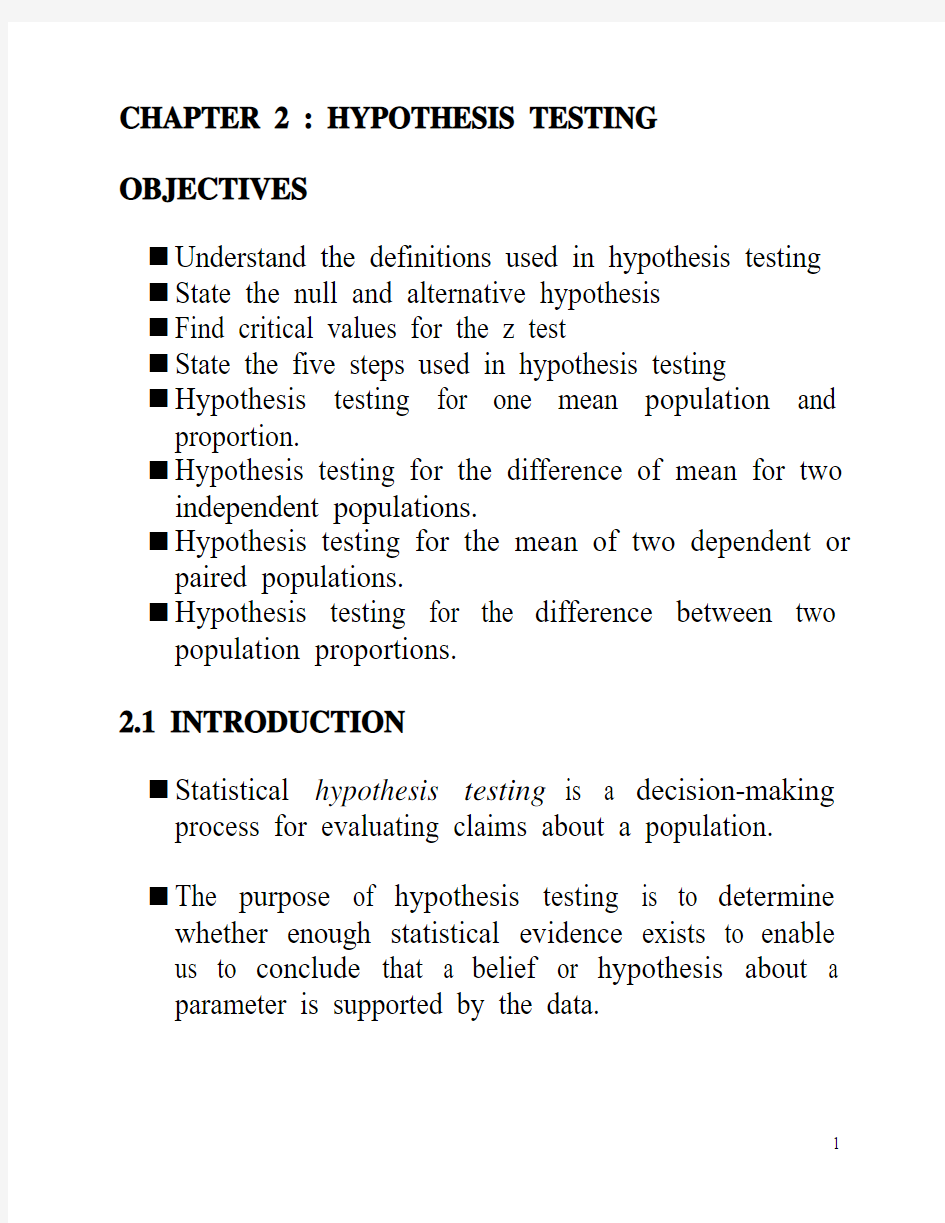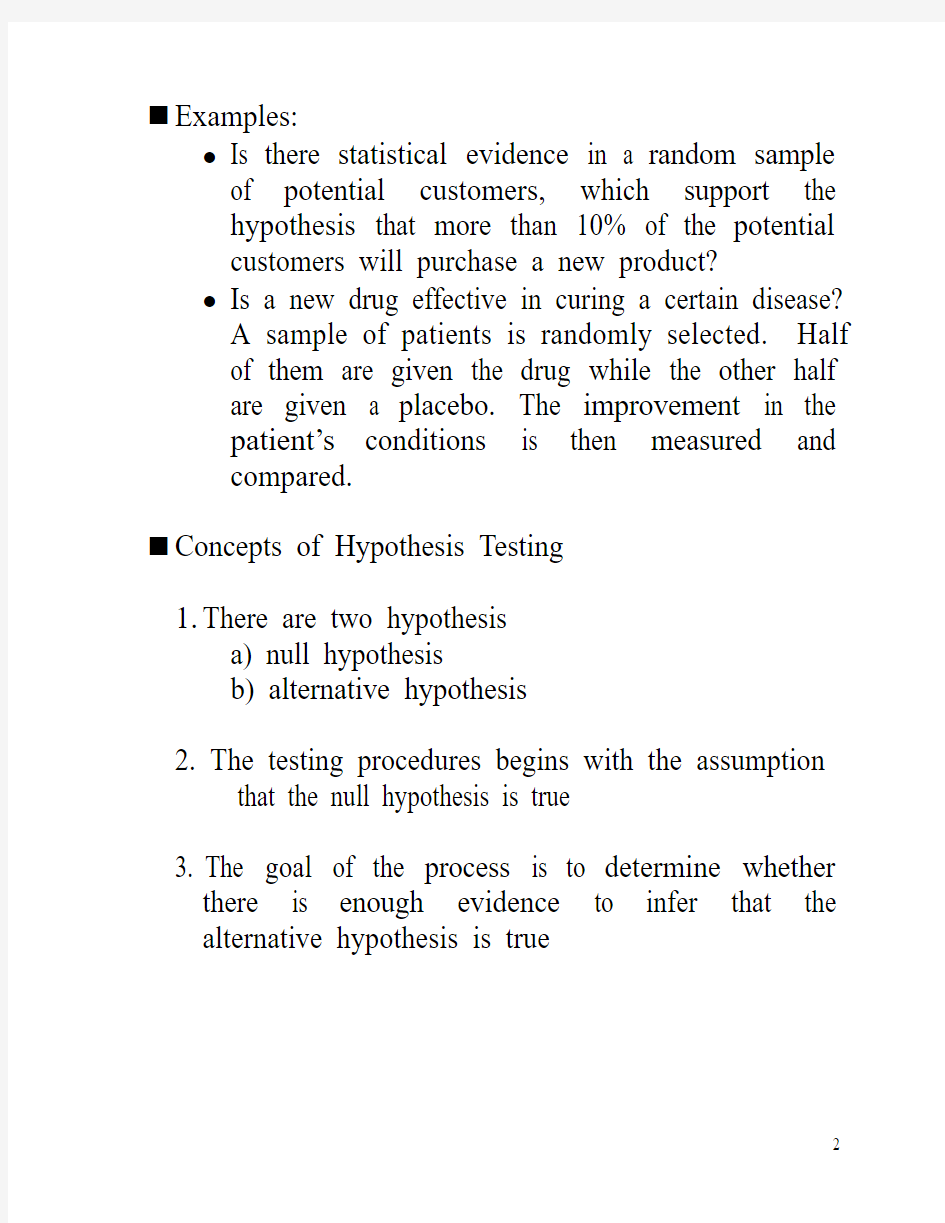Hypothesis_Testing-One_Population


CHAPTER 2 : HYPOTHESIS TESTING OBJECTIVES
?Understand the definitions used in hypothesis testing ?State the null and alternative hypothesis
?Find critical values for the z test
?State the five steps used in hypothesis testing
?Hypothesis testing for one mean population and
proportion.
?Hypothesis testing for the difference of mean for two
independent populations.
?Hypothesis testing for the mean of two dependent or
paired populations.
?Hypothesis testing for the difference between two
population proportions.
2.1 INTRODUCTION
?Statistical hypothesis testing is a decision-making
process for evaluating claims about a population.
?The purpose of hypothesis testing is to determine
whether enough statistical evidence exists to enable us to conclude that a belief or hypothesis about a parameter is supported by the data.
?Examples:
?Is there statistical evidence in a random sample
of potential customers, which support the
hypothesis that more than 10% of the potential
customers will purchase a new product?
?Is a new drug effective in curing a certain disease?
A sample of patients is randomly selected. Half
of them are given the drug while the other half
are given a placebo. The improvement in the
patient’s conditions is then measured and
compared.
?Concepts of Hypothesis Testing
1.There are two hypothesis
a) null hypothesis
b) alternative hypothesis
2. The testing procedures begins with the assumption that the null hypothesis is true
3. The goal of the process is to determine whether
there is enough evidence to infer that the
alternative hypothesis is true
4. There are two possible decisions:
a) Reject the null hypothesis –
conclude that there is enough evidence to
support the alternative hypothesis.
b) Do not reject the null hypothesis –
conclude that there is not enough evidence to support the alternative hypothesis.
5. Two possible errors can be made in any test.
a) Type I error
b) Type II error
Steps Used in Hypothesis Testing
1.State the hypothesis and identify the claim
2.Find the critical value from appropriate table (z or t
distribution)
https://www.360docs.net/doc/0616468802.html,pute the test statistics
4.Make the decision to reject or not reject the null
hypothesis
5.Conclusion
?Statement of a Hypothesis
?A statistical hypothesis is a conjecture about a population parameter which may or may not be true.
?There are two types of statistical hypotheses for each situation: the null hypothesis and the alternative hypothesis.
?The null hypothesis, symbolized by H0 (H-nought), is a statistical hypothesis that states that there is no difference between a parameter and a specific value, or that there is no difference between two parameters.
?The alternative hypothesis, symbolized by H1, is a statistical hypothesis that states the existence of a difference between a parameter and a specific value, or states that there is a difference between two parameters.
?Example 1
A survey claim that the average cost of a hotel room in Atlanta is $69.21. To test the claim, a researcher selects a sample of 30 hotel rooms and found that the average cost is $68.43.
?H0: null hypothesis μ = 69.21
?H1: alternative hypothesis μ≠ 69.21
?Example 2
An operation manager needs to determine if the mean demand during lead time is greater than 350. If so, changes in the ordering policy are needed.
?H0: null hypothesis μ≤ 350
?H1: alternative hypothesis μ > 350
H ypothesis Testing Common Phrases
?In order to state hypothesis correctly, translate the conjecture or claims from word into mathematical symbols.
?The basic symbol used are as follow:
> <
Greater than Less than
increased decreased
≥≤
Greater than or equal Less than or equal
At least At most
= ≠
Equal Not equal
has no changed has changed
?The null and alternative hypothesis are stated together, and the null hypothesis contains the equal sign (where k represents a specific number)
Two-tailed Right-tailed Left-tailed
H0 : μ = k H0 : μ≤ k H0 : μ≥ k
H1 : μ≠ k H1 : μ > k H1 : μ < k
?Statistical Test
?After stating the hypothesis, selects the correct statistical test, and choose an appropriate level of significance.
?A statistical test uses the data obtained from a sample to make a decision about whether or not the null hypothesis should be rejected.
?The numerical value obtained from a statistical test is called the test value.
?Possible Outcomes of a Hypothesis Test
?Two type of errors:
A type I error occurs if one rejects
the null hypothesis when it is true.
A type II error occurs if one does not
reject the null hypothesis when it is false.
?Probabilities of error
1. P(type I error) = α
The level of significance is the maximum
probability of committing a type I error
In most situation, the researcher decides
what level of significance to use
2.P(type II error) = β
not easily be computed
?αand βare related in that decreasing one
increases the other.
Reject H0
Do not reject H0
C ritical Values
?In a hypothesis testing situation, decide what level
of significance to use.
?After a significance level is chosen, a critical value
is selected from a table for the appropriate test.
?The critical value(s) separates the critical region from the noncritical region. The symbol for critical value is C.V
?The critical or rejection region is the range of values of the test value that indicates that there is a significant difference and that the null hypothesis should be rejected.
?The noncritical or nonrejection region is the range of values of the test value that indicates that the difference was probably due to chance and that the null hypothesis should not be rejected.
One Tailed-Test
?A one-tailed test indicates that the null hypothesis should be rejected when the test value is in the critical region on one side of the mean.
?A one-tailed test is either right-tailed or left-tailed, depending on the direction of the inequality of the alternative hypothesis
Left-Tailed Test
Right-Tailed Test
Two-Tailed Test
? In a two-tailed test , the null hypothesis should be rejected when the test value is in either of the two critical regions.
? The critical region must be split into 2 equal parts.
T est Statistics
? Assume H 0 is true ? General formula
(Observed value)-(Expected value)
Test Value = Standard Error
? The observed value is the statistics (such as mean) that is computed from the sample data.
? The expected value is the parameter (such as mean) obtain from the null hypothesis. 1) T he Z Test
? A statistical test for the mean and proportion of a population.
? It can be used when the population is normally distributed and σ is known or when σ is unknown but n ≥ 30.
? The formula for the z test:
X z μσ-=
or
X z μ-=
2) T he t Test
? A statistical test of the mean of a population
? Is used when the population is normally or approximately normally distributed, σ is unknown and n < 30.
? The formula for the t test:
The degrees of freedom are d.f. = n –1.
3) Z Test for Proportion
? A hypothesis test involving a population proportion can be considered as a binomial experiment when there are only two outcomes and the probability of a success does not change from trial to trial. ? Formula:
p p z ∧
-=
where p ∧
= X n
p = population proportion
q = 1p -
X t μ-=
D ecision
? Only two decision: reject H 0 or do not reject H 0 ? H 0 is rejected when the different between the population parameter and the sample statistic is said to be significant.
? The different is significant when the test value falls in the critical region of the distribution.
C onclusion
? If we reject H 0, we conclude that:
→ There is enough evidence to infer that the alternative hypothesis is true.
? If we do not reject H 0, we conclude that:
→ There is not enough evidence to infer that the alternative hypothesis is true.
1. Claim is H
Reject H 0 Do not reject H 0
2. Claim is H
1
Reject H 0 Do not reject H 0
2.2 Hypothesis Testing for Population Mean
1) H ypothesis Statement
H 0: k μ=
H 1: or or k k k μμμ≠<> 2) C ritical Value
3) T est Statistics:
a) X z μ-= or X z μ
-=; σ is known or
σ unknown and n ≥ 30
b) ; σ is unknown and n < 30
X t μ-=
4)D ecision
5)C onclusion.
Example:
Test the following hypothesis.
μ=
H0: 100
μ≠
H1: 100
σ=10, n=100, x=100, α=0.05
Exercise
μ=
1. H0: 50
μ<
H1: 50
σ=15, n=100, x=48, α=0.05
2. A random sample of 18 young adult men (20-30
years old) was sampled. Each person was asked haw many minutes of sports they watched on television daily. The responses are listed here. It is known that σ=12. Test to determine at the 5% significance level whether there is enough statistical evidence to infer that the mean amount of television watched daily by all young adult men is greater than 50 minutes.
55 60 65 74 66 37 45 68 64
65 58 55 52 63 59 57 74 65
3. A statistics practitioner is in the process of testing to
determine whether there is enough evidence to infer that the population mean is different from 220. She calculate the mean and standard deviation of a sample of 200 observations as x=215 and s=22.
Test the claim at 5% significance level.
2.3 Hypothesis Testing for Proportion
1) H ypothesis Statement H 0: p c = 0
2) C ritical Value
3) T est statistic
p p z ∧
-=
4) D ecision
5) C onclusion
Example:
Test the following hypotheses given that ?p=0.63 and n=100.
0 1:0.60 :0.60
H p H p = >
Exercise:
1. A political candidate wishes to know if more than
50% of the population supports her candidacy.
Using a random sample of 900 voters, she finds that 55% would vote for her.
a.Write the hypothesis test and indicate the critical
value with α=0.05.
b.What is your conclusion?
2.A market research study is designed to determine if
30% or more of the people in large southern state
would purchase a new brand of frozen spiced
chicken. A random sample of 500 persons is
obtained. They are given a portion to eat and then
asked if they would purchase the product. Test the
claim with α=0.05.
Hypothesis Testing For One Population Using the SPSS Output
The steps for hypothesis testing using the SPSS output are:
1. Hypothesis statement
2. Decision (Compare p value with significance level)
3. Conclusion
Decision rule when using the p-value
? We can conclude that the smaller the p -value, the more statistical evidence exists to support the alternative hypothesis.
? The p value from the output is for two tail test. For one tail test, divide the p value by 2.
If -value reject the null hypothesis.If -value do not reject the null hypothesis.P P αα<→≥→
A machine is set to fill a small bottle with 9.0 grams of medicine. A sample of eights bottles revealed the following amounts (grams) in each bottle.
9.2 8.7 8.9 8.6 8.8 8.5 8.7 9.0
At the 0.01 significance level, can we conclude that the mean weight is less than 9.0 grams?
1. Many grocery stores and large retailers such as K-Mart have installed self-checkout systems so shoppers can scan their own items and cash out themselves. How do customers like this service and how often do they use it? Listed below is the number of customers using the service for a sample of 15 days at the K-Mart.
120 108 120 114 118 91 118 92 104 104 112 97 118 108 117
Is it reasonable to conclude that the mean number of customers using the self-checkout system is more than 100 per day? Use the 0.05 significance level.
